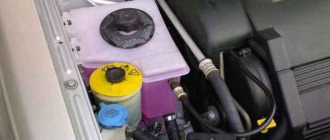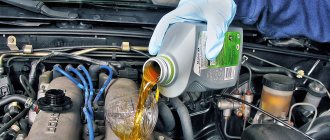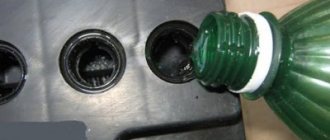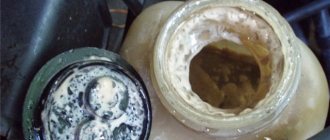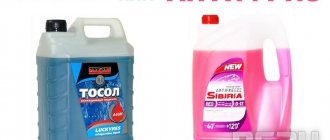Why should you add coolant?
Antifreeze is the common name for special engine coolants. During operation, they circulate through a special circuit, which allows the generated heat to be removed. The heated antifreeze is transferred to the radiator, where it is rapidly cooled. If there is not enough process fluid or its quality is lost, then the temperature of the power unit will rapidly exceed the limit level. An overheated engine wears out quickly and may stall or even seize.
What happens if you pour water into a foreign car?
If for a short time (say for a day, two or a maximum of a week) - there will be absolutely nothing! The main thing is to then drain the water and fill it with normal (as recommended by the manufacturer - antifreeze, according to tolerances). Well, it’s worth remembering about the temperature regime of the surrounding air; if the temperature outside is sub-zero, the water will simply freeze.
It’s worth mentioning right away that modern foreign cars often have sensors that can measure the density of the coolant, even if ordinary water is filled. The engine just won't start
Thus, if you need to rest for a short time, for example, you are on the road, but there are no shops in the area, and the radiator is leaking, then pour water - the main thing is that it is clean, without dirt. Nothing bad will happen!
BUT if you want to ride on a regular basis, I personally don’t recommend it.
Why antifreeze
It would seem, why use special fluids if water can also cool the engine? In fact, buying antifreeze is a necessity. Water evaporates quickly and can freeze, and it also activates corrosion processes and forms scale deposits. Automotive coolant is made from ethylene glycol and water. The resulting solution of dihydric alcohol does not freeze even at low temperatures and practically does not boil away when heated strongly. In addition, antifreeze contains a complex composition of corrosion inhibitors that slow down and stop oxidation processes.
Flushing the system
The need to flush the car's cooling system may arise in the following cases:
- The antifreeze used has become very black and/or thickened. In this case, it must be replaced completely, despite its specified service life. This fact can be caused by two main reasons - either you forgot to change the fluid according to the regulations, or you bought a fake.
- If it is necessary to add more than 30% of antifreeze to the existing volume. In this case, the existing “coolant” must be drained and the system flushed using distilled or ordinary water. You can also use other, more effective means for this.
How to flush the engine cooling system
There are at least 4 ways to flush the engine cooling system. One of them is to rinse the outer part with ordinary water, but it is better to rinse the inside with a solution of citric acid or a special product.
Adding coolant is a simple procedure, and even an inexperienced car owner can handle it. The main thing is to follow safety precautions (perform the procedure with a cold engine and cooling system), and also choose the right antifreeze that you plan to add. Try to ensure that no air pockets form during the topping process.
When to add coolant
How often do you add antifreeze? It is impossible to give an exact answer to this question for all cases. It all depends on the following variable factors:
- type of coolant;
- refrigerant composition;
- additive compositions;
- features of vehicle operation.
Today, the market offers coolants made on the basis of silicate and carbosilicate. Original silicate antifreeze from a good manufacturer retains its quality for 3 years or 150 thousand km. Carbosilicate liquids can last up to 5 years or 250 thousand km. When deciding to add antifreeze to your car, you must first read the recommendations of the car manufacturer.
How much oil should I add to the engine?
To control the level, an oil dipstick is provided in any internal combustion engine. It is necessary to make it a rule to check the volume of technical fluids at least once a week.
The easiest way is to do this before you start moving. If your car is in a garage or parked: before starting the engine, open the hood, remove the dipstick, and wipe it dry. Then put it back in and take it out again.
Engine oil level on dipstick
The main condition is a flat horizontal surface: if you park on a curb, the readings will be incorrect. The oil mark should be between the “MIN” and “MAX” marks. As a rule, the difference between these marks is 1 liter.
It is not necessary to strictly maintain the middle; an oil trace anywhere between the marks means a normal level.
Important! Excess oil is no less harmful than too low a level. “Excess” lubricant gets onto the piston group, under the influence of temperature it separates into components, and falls out in the form of slag. Deposits clog oil channels, impairing circulation.
In addition, excess lubricant leads to an increase in pressure in the crankcase, as a result of which oil seals or gaskets can depressurize: they are simply squeezed out of their seats. Excess fluid loads the oil pump, which leads to accelerated wear.
Accordingly, a low level leads to oil starvation (the consequences can lead to unplanned overhauls).
How does operation affect
Abnormal engine operating conditions are a powerful factor in reducing the quality of the coolant. They may require topping up or completely replacing antifreeze. Typical negative factors include the following situations:
- prolonged operation of an overloaded vehicle;
- driving with low refrigerant levels;
- emergency topping up of unsuitable antifreeze;
- water entering the cooling system.
Consequently, the operating conditions of the vehicle also greatly influence how often antifreeze needs to be added.
Choosing antifreeze to replace
The refrigerant must be replaced if it has expired, as well as if the car is serviced after active use in summer or winter.
If the previous coolant performed its function properly, it is worth filling in the same one. Before this, it is advisable to flush the cooling system with water, preferably distilled, by allowing the engine to pump it through all the pipes and radiators, warming it up to a temperature at which the valve releases liquid in a large circle.
If the coolant is seriously contaminated, for example, after using sealants, ordinary water, or mixing antifreeze with radically different flushing compositions, you will need to use a special flushing agent, after which the system must be cleaned with distilled water. After this, you can fill the system with new antifreeze.
You can get rid of excess air after filling the coolant by bleeding it through the pipe in the upper part of the cylinder block. If necessary, the expansion tank is additionally filled with antifreeze to the normal level.
Before adding antifreeze, you need to decide on its type. Remember that, ideally, you should always only use the coolant recommended by your vehicle's manufacturer. You will find detailed information in the manual or reference literature. In most cases, the use of coolants of different classes and brands is allowed. And when topping up, use only the one that was filled in earlier. Failure to comply with this rule may result in a malfunction of the cooling system.
As for the Hyundai Solaris car, the following types of antifreeze can be used for it:
- G-11. Such compositions belong to the hybrid group - hybr{amp}gt; If it is necessary to add more than 30% of the total volume, then it is better not to add antifreeze, but to completely fill in new fluid.
Accordingly, only hybrids can be mixed with hybrids, carboxylates with carboxylates, and lobrides with lobrides. Mixing antifreeze of different classes is strictly prohibited. The only exception is G12 class antifreeze, which can be added to G11 and G12 fluids. Also, you cannot add domestic “Antifreeze” to antifreeze, since their chemical compositions are very different.
Remember that antifreeze is sold in stores in two formulations - completely ready for pouring into the cooling system and as a concentrate. Pay attention to this, since pure concentrate cannot be added to the existing coolant in the car system. Even if they belong to the same class.
Typical mistakes when adding coolant
It is necessary to replenish the refrigerant level in the system not only on time, but also correctly. In their manuals, car manufacturers describe in detail all the details of the procedure. There are always recommendations on the packaging of any antifreeze. But to many motorists the process itself seems simple, so no one delves into the technical documentation. So that you can avoid common mistakes, we have prepared a rating of them.
1. Constant rush
Automotive and coolant manufacturers emphasize in bold letters, warnings, and exclamation marks the strict need to add antifreeze to a “cold” system. At a minimum, the car should stand with the engine turned off for at least 10 minutes. What are the consequences of a violation? First of all, it is dangerous. When adding cold liquid to hot liquid, a characteristic bubbling begins. As a result, the hasty motorist gets burns on his hands and greasy stains in the engine compartment. But there is also a technical aspect. The heated liquid occupies the maximum volume, so you will only need to add a little. As it cools, the antifreeze level will drop, but you won’t notice it.
2. Adding water
The chemical composition of automotive coolant is calculated based on the standard water content - approximately 5%. At this concentration, all anti-corrosion, anti-foam and other performance properties of the product are preserved. If you simply add water, then it is no longer possible to guarantee any properties of the entire liquid. Such actions often lead to freezing, which ultimately damages the line and radiator. Adding water is allowed only in emergency situations, when you need to raise the coolant level, but there is nowhere to get a suitable composition. Immediately after an abnormal dilution of antifreeze, you need to go to a service station to flush the system and fill it with good refrigerant.
3. Sudden movements
This error is also related to security issues. It lies in the fact that some motorists sharply unscrew the filler cap. If the machine has recently been operated, such actions may result in the release of a large volume of hot steam. To protect yourself from burns, you need to act carefully and slowly.
4. More is not better
There is no need to confuse antifreeze and engine oil. If the latter needs to be filled to the limit, then it is better to stop the coolant level in the middle of the expansion tank. If there is an excess of liquid, its thermal expansion will lead to increased pressure in the system. At best, this will result in a cracked tank, but you may also encounter ruptures in the system.
5. Matching by color
Adding antifreeze according to rules like “red to red” or “blue to blue” is a gross mistake. In fact, no one regulates the color schemes of manufacturers. The choice of coolant should be based on its chemical composition.
How to add antifreeze to the cooling system?
It is recommended to pour new antifreeze only into a clean cooling system. However, before doing this, it is important to understand what exactly you are going to fill. After all, there is no such confusing classification as that of coolants anywhere else.
To avoid the formation of air jams in the system, place the car in a strictly horizontal position.
1)
. We disconnect the uppermost pipe that supplies antifreeze to the engine (as a rule, it is located in the area of the intake manifold).
2)
. We pour new antifreeze through the neck of the expansion tank, which is most conveniently done using a funnel.
3)
. We fill until it begins to flow out of the disconnected pipe, after which we put the pipe in place and clamp it at the connection with a clamp.
4)
. The optimal level to fill is between o and “MAX”.
5)
. After filling, close the tank cap tightly, start the car and warm it up until the fan operates.
7)
. Top up if necessary. Once again I want to note that we perform the last point only with a cold engine.

